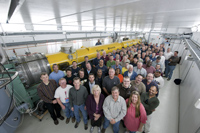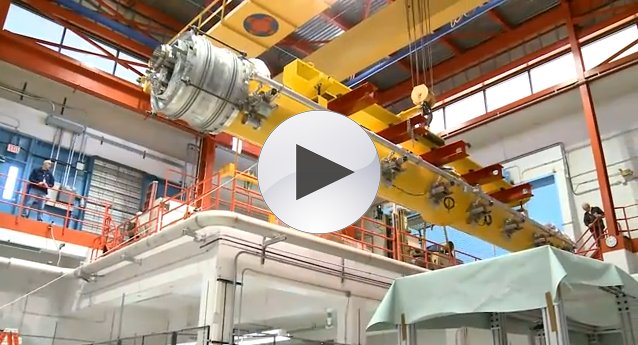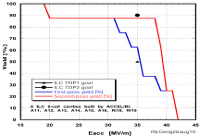From Fermilab Today: Fermilab begins operation of first SRF cryomodule

More than 100 Fermilab employees contributed to the Cryomodule 1's assembly and operation. They include scientists, engineers, technicians, safety personnel and administrators. Photo: Reidar Hahn |
Editor's note: Watch our video of the week, showing the installation of the first SRF cryomodule at Fermilab.
At particle physics laboratories around the world, people have closely followed a much anticipated cooldown at Fermilab.
Years of effort by more than 100 staff members at Fermilab have led to the cooldown of Cryomodule 1 at the laboratory's SRF Accelerator Test Facility. At 11 a.m. on Nov. 22, liquid helium flowed through CM1, cooling it to 2 Kelvin (-271° C).
Read more...
-- Leah Hesla |
|
 |
 |
|
|
 |
From KEK: Japanese 9-cell SCRF cavity meets ILC specifications

Scientists working on cavity vertical test at STF. Image: Akira Yamamoto |
Designing and fabricating an optimal accelerating cavity is not so simple. There are two important parameters scientists are looking for: the gradient of 35 megavolts per meter (MV/m) and the quality factor (Q0) of > 0.8×1010. A Japanese cavity now fulfilled those requirements for the first time at a test which took place at the Superconducting radiofrequency Test Facility (STF) at KEK, adding momentum towards future mass production.
Accelerating gradient and an unloaded quality factor (Q0) are two important parameters for realizing the ILC. The accelerating gradient is a measure of how much an accelerator can increase the energy of a particle over a given stretch, typically indicated by the unit MV/m. The higher the gradient, the shorter the accelerator, and hence, the cheaper the system can be built. The quality factor, Q0, is a qualifier of how well the cavity can sustain the stored RF power. A higher Q0 means a lower rate of power loss relative to the stored energy.
Read more...
-- Rika Takahashi |
 |
|
|
 |
Cryogenic Module installed at Fermilab

Watch a video of the installation of the first ILC-type superconducting cryomodule at Fermilab. Read also this week's related story to learn more about the cool down of the first eight-cavity SRF cryomodule of its type in the United States on 23 November 2010. Video: Fermilab.
|
 |
|
|
 |
From Astronomy
6 December 2010
Road trip: Fermi National Accelerator Laboratory, part 2
When you hear the name Fermi National Accelerator Laboratory, or Fermilab for short, cosmology likely isn't the first thing to cross your mind. ...
Read more... |
|
From CERN
6 December 2010
CERN experiment makes progress towards antihydrogen beams
The ASACUSA experiment at CERN2 has taken an important step forward in developing an innovative technique for studying antimatter. Using a novel particle trap, called a CUSP trap, the experiment has succeeded in producing significant numbers of antihydrogen atoms in flight.
Read more... |
|
From Le Figaro.fr
3 December 2010
Des télescopes sous l'eau pour écouter le chant des baleines
Les détecteurs de neutrinos cosmiques ont trouvé une nouvelle application. Les cétacés utilisent en effet les mêmes fréquences que ces particules pour communiquer.
Read more... (in French) |
|
|
 |
Evolving the ILC baseline: main linac operating gradient

Encouraging recent gradient yield results presented at Baseline Assessment Workshop BAW-1 by Rong-Li Geng achieving our second-pass Technical Design Report goal of 90% yield at 35 MV/m, although with very limited statistics |
Last week I described the motivation and the process for evolving the baseline for the technical design effort that we will be carrying out over the next two years, culminating in a Technical Design Report (TDR) at the end of 2012. The baseline for the TDR is being evolved by making a series of specific changes, of which four of the proposed changes have been determined to have impacts that require a "top-level change control" action. I defined that process last week.
Read more...
-- Barry Barish
Director's Corner Archive |
 |
|
|
 |
ECFA extends the "Study of physics and detectors for a linear collider"
On 26 November, the European Committee for Future Accelerators decided to extend the period of the "ECFA Study of Physics and Detectors for a Linear Collider" till the end of 2013 and appointed Juan Fuster as the new chair of this study group. These ECFA decisions confirm its support to the European activities on linear colliders, especially in the important coming period for the project. The mandate of former chair François Richard has come to an end, along with his other international duties, in particular being a Worldwide Study co-chair and a regional representative to the ILC Research Director Sakue Yamada. Juan Fuster is a very active supporter of the ILC activity in Spain and has been, among other things, the organiser of the ECFA workshop in Valencia in 2006.
- View slides of the latest ECFA meeting at CERN
- Latest "ECFA Study of Physics and Detectors for a Linear Collider"
workshop at CERN
arXiv preprints
1012.1035
Measuring a Light Neutralino Mass at the ILC: Testing the MSSM Neutralino Cold Dark Matter Model
1012.0824
Electroweak non-resonant corrections to top pair production close to threshold
1012.0189
Indirect search for color octet electron at next generation linear colliders
1012.0167
The Higgs sector of the minimal B–L model at future Linear Colliders
1011.6314
Design and Construction of a Cherenkov Detector for Compton Polarimetry at the ILC
1011.5969
Performance of Glass Resistive Plate Chambers for a high granularity semi-digital calorimeter
|
|

